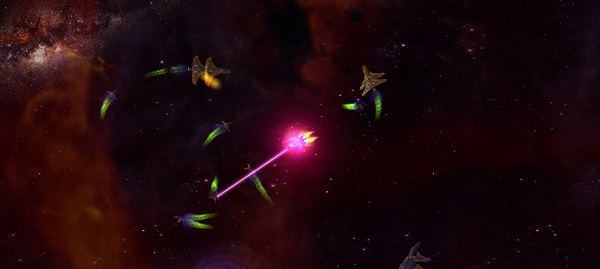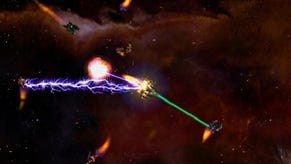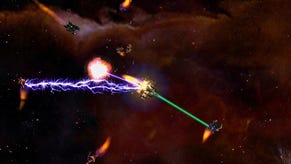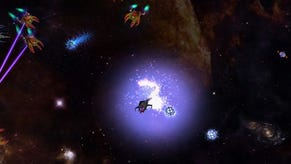Wot I Think: Drox Operative
Action (role playing game) with consequences
Twas the day before week’s end, when all throughout space,
Dark troubles were stirring, a deadly arms race!
The void filled with beacons, transmissions and prayers,
In hopes a Drox Operative soon would be there.
I've been exploring space sectors in Soldak's latest ARPG. Here's wot I think.
Being cut from the same cloth as previous Soldak titles - Din’s Curse and Depths of Peril - Drox Operative is not a typical action roleplaying game. Rather than rolling the player down a lane like a gradually accelerating, spike-accruing bowling ball smashing through increasingly robust collections of pins, Drox plants them in the middle of a playfield filled with packs of enemies, spacefaring civilisations and the occasional dimensional pocket or other surprise.
I found it incredibly confusing at first, perhaps because I had the comparison to Space Rangers 2 in the back of my mind. Although there are similarities between the two, Drox is definitely an ARPG rather than whatever the hell Space Rangers is. A spaceship biographer drifting around a dynamic galaxy? No, that’s not quite right. A Russian spaceship biographer drifting around a dynamic galaxy. That’s what space Rangers 2 is.
Back to Drox though, which is certainly an ARPG but also has the ‘living’ world aspect of both Space Rangers and Soldak’s earlier games. The player is the titular operative, sent into randomised space sectors to bring about peace, profit or peril, depending on his/her mood and the specifics of the situation. I spent much of last night acting as a devious weapons broker in a brewing battle between the Shadow and humankind. There are no humans left in that sector now (sorry) but I’m swimming in credits and allied with the Shadow, who are destined to dominate everybody thanks to all the tech I’ve discovered in far-flung, hazardous zones and flogged to them at crazy-cheap prices.
If you care to, and if the politics and positions of the races are suitable, it’s possible to create diplomatic victories by uniting the separate civilisations. Some are more bloodthirsty than others though and even the most mild-mannered become aggressive when their backs are to the wall.
Or, if you’re more of the lone hero type, take quests, travel through jumpgates, trade, destroy legendary spacebastards and marauding fleets, and be a do-gooder or renegade with no affiliation other than the essential one to the Drox Operatives themselves. They are the organisation that kitted you out and sent you out into the messy melting pot between stars, so you do owe them something and they’ll upgrade your crew and ship when you level up, so all’s fair. Plus, earn enough money in a sector and they’ll allow you to move on, ticking it off the infinite list of ‘things to do’.
The confusion that blinkered my first impressions arose as soon as I thrusted away from my starting location and found myself beset by a squadron of enemy ships. Who were they and would destroying them change the balance of the sector? Even worse, would they destroy my feeble little ship? The answer to both questions was a firm ‘no’. Unless ships or spacebeasts belong to a civilisation, they can be zapped happily into pieces, just like wandering bands of goblins or skeletons. They’re mostly easy prey, at first, and soon you’ll be leading them toward populated planets and THEN smiting them, enjoying the reputation boost that follows.
Confusion continues when contact is made with the various sentient species in a sector. There are so many possibilities. Should you engage in propaganda, sabotage and espionage? Undertake the quests they are offering? Soon, updates are pinging onto the bottom of the screen, informing you of developments that appear to be urgent and necessary. Civil unrest on a nearby planet requires delivery of non-lethal weapons, or the botanical Dryad may want to colonise the large desert planet you drifted past a few minutes ago. What to do?
The answer is not to worry too much. Things will happen with or without your involvement and it’s best not to divide your attention between all the galactic goings-on. If you want to help the treefolk spread, chat to them and they’ll tell you what they need and you can become a coloniser for a while. If you’d rather nip their expansionist plans in the bud, make sure they don’t get hold of the necessary equipment by cutting off supplies.
As soon as I had decided on a mission and a long-term goal, influenced by the win and lose states that the game details and tracks, I quickly learned to enjoy my time in each sector. As a wise book once said: Don’t Panic.
For a player like me, who likes to believe the world carries on even when I’m not looking, Soldak’s take on the ARPG is by far the most interesting I’ve encountered and Drox Operative, while I find it more abstract than Din and Depths, offers more possibilities. The less immediate nature of the space combat isn’t as well suited to the pointing, clicking and number key punching that has become an oddly acceptable shorthand for axe swinging and spell casting. However, each sector has so much to offer in terms of sly politicking and heroic salvation. The game just requires that you meet it half way with a healthy dollop of imaginative interpretation.
Of the ARPGs I’ve spent more than a couple of hours with this year, it breaks down as follows:
Diablo III – 15 hours or so. During the first five, I was happily collecting loot and dropping bells on zombies or punching them so hard that all their skin fell off and turned into a puddle. The rest was a grim-faced journey of the same that left me wondering if I ever actually enjoyed Diablo II as much as I thought I did.
Torchlight 2 – around five hours. Not because I wasn’t enjoying it but because that was enough time to convince me I’d enjoy playing it with a friend when free time was available.
Drox Operative – almost 30 hours. And I’m just getting started. The first couple of hours were disappointing as I struggled to find a connection. What is a Drox Operative anyway and what is it supposed to do, I definitely didn’t shout at the screen. Why are there so many types of ship and what is it all about? Should I be doing that thing, is that where the fun starts?
Silly me. A Drox Operative is, quite simply, a person with a badass spaceship who does whatever seems like a good idea at the time, with backing from a shadowy collective who provide upgrades and new ships when they see results. The operative might spend his/her time solving problems, creating problems, ignoring problems, but what’s essential is to use the space you’re given as a personal playground. Soldak provides a canvas, not blank but bristling with intent, and the spaceship, lasers and nuclear missiles are your brushes.
At first, it’s a little vague and clumsy, like a drunk politician, but once you allow your eyes to adjust, the bar that fills when a planet is explored might just become an image of forests coming into view, and diplomatic dealings with an aggressor, bombarding a friendly planet from orbit, could become a tale for the ages. While it doesn’t have the flashy, immediate appeal of a conventional Pinata-popper like Diablo, Drox Operative provides the greater gift of a world in which the action part of ARPG has consequences, as does inaction.
It’s the advancement of the genre that so many people have given up on searching for and Soldak have been providing it for years.
Drox Operative is available now for $19.99 on Windows and Mac. Maybe you'd like to try the demo?
















